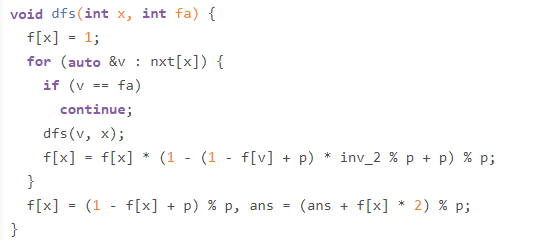可以证明:
一个树的邻接矩阵的秩,等于最大匹配数*2(虽然我只能证明下界是最大匹配)
而树的最大匹配可以贪心,
不妨用DP模拟这个过程
f[x][0/1]表示,x为根的子树,所有情况下,按照贪心使得x被选/没有没选,的最大匹配的总和
g[x][0/1]为方案数。
转移时候讨论即可。
#include<bits/stdc++.h> #define reg register int #define il inline #define fi first #define se second #define mk(a,b) make_pair(a,b) #define numb (ch^'0') #define pb push_back #define solid const auto & #define enter cout<<endl #define pii pair<int,int> using namespace std; typedef long long ll; template<class T>il void rd(T &x){ char ch;x=0;bool fl=false;while(!isdigit(ch=getchar()))(ch=='-')&&(fl=true); for(x=numb;isdigit(ch=getchar());x=x*10+numb);(fl==true)&&(x=-x);} template<class T>il void output(T x){if(x/10)output(x/10);putchar(x%10+'0');} template<class T>il void ot(T x){if(x<0) putchar('-'),x=-x;output(x);putchar(' ');} template<class T>il void prt(T a[],int st,int nd){for(reg i=st;i<=nd;++i) ot(a[i]);putchar(' ');} namespace Modulo{ const int mod=998244353; int ad(int x,int y){return (x+y)>=mod?x+y-mod:x+y;} void inc(int &x,int y){x=ad(x,y);} int mul(int x,int y){return (ll)x*y%mod;} void inc2(int &x,int y){x=mul(x,y);} int qm(int x,int y=mod-2){int ret=1;while(y){if(y&1) ret=mul(x,ret);x=mul(x,x);y>>=1;}return ret;} template<class ...Args>il int ad(const int a,const int b,const Args &...args) {return ad(ad(a,b),args...);} template<class ...Args>il int mul(const int a,const int b,const Args &...args) {return mul(mul(a,b),args...);} } using namespace Modulo; namespace Miracle{ const int N=5e5+5; int n; struct node{ int nxt,to; }e[2*N]; int hd[N],cnt; void add(int x,int y){ e[++cnt].nxt=hd[x]; e[cnt].to=y; hd[x]=cnt; } int f[N][2],g[N][2]; void dfs(int x,int fa){ g[x][0]=1; for(reg i=hd[x];i;i=e[i].nxt){ int y=e[i].to; if(y==fa) continue; dfs(y,x); int f1=0,f0=0,g1=0,g0=0; //exi inc(f1,ad(mul(f[x][0],g[y][0]),mul(g[x][0],f[y][0]),mul(g[x][0],g[y][0]))); inc(f1,ad(mul(f[x][1],g[y][0]),mul(g[x][1],f[y][0]),mul(f[x][1],g[y][1]),mul(g[x][1],f[y][1]))); inc(g1,ad(mul(g[x][0],g[y][0]),mul(g[x][1],g[y][0]),mul(g[x][1],g[y][1]))); inc(f0,ad(mul(f[x][0],g[y][1]),mul(g[x][0],f[y][1]))); inc(g0,mul(g[x][0],g[y][1])); //not inc(f1,ad(mul(f[x][1],ad(g[y][0],g[y][1])),mul(g[x][1],ad(f[y][0],f[y][1])))); inc(f0,ad(mul(f[x][0],ad(g[y][0],g[y][1])),mul(g[x][0],ad(f[y][0],f[y][1])))); inc(g1,mul(g[x][1],ad(g[y][0],g[y][1]))); inc(g0,mul(g[x][0],ad(g[y][0],g[y][1]))); f[x][1]=f1;f[x][0]=f0;g[x][1]=g1;g[x][0]=g0; } } int main(){ rd(n); int x,y; for(reg i=1;i<n;++i){ rd(x);rd(y);add(x,y);add(y,x); } dfs(1,0); int ans=mul(ad(f[1][0],f[1][1]),2); ot(ans); return 0; } } signed main(){ Miracle::main(); return 0; } /* Author: *Miracle* */
然后CF讨论里一个julao提出一个更简单的方法
直接计算f[x]表示x和某个儿子有匹配的概率
根据期望的线性性,直接f[x]相加就是答案。
那么,f[x]=1-无法匹配的概率,
代码如下:
